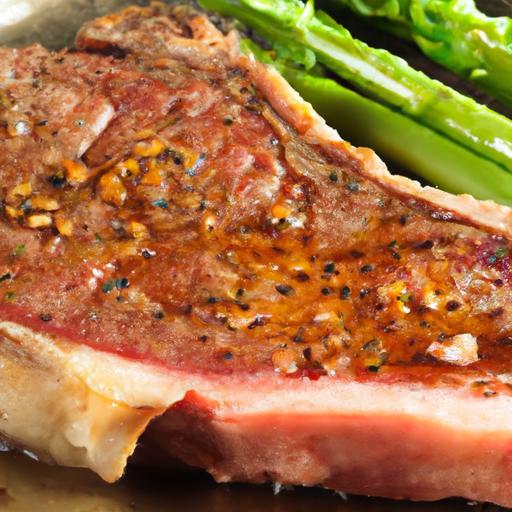Few culinary experiences rival the sizzle and aroma of a perfectly seared steak, its caramelized crust giving way to a tender, juicy center. Achieving steakhouse-quality results at home is not a mystery reserved for professional chefs-it’s an art that anyone can master with the right technique and tools. Enter the cast iron skillet: a trusty kitchen companion renowned for its heat retention and even cooking, ideal for creating that coveted sear. In this article, we’ll delve into the secrets of sear perfection, guiding you step-by-step to transform a simple cut of meat into a mouthwatering masterpiece sizzling with flavor. Whether you’re a seasoned cook or a curious beginner, prepare to elevate your steak game and impress every palate.
Sear Perfection begins with choosing the right steak-an essential step that sets the stage for that deeply flavorful crust only a cast iron skillet can deliver. Prime cuts like ribeye, striploin, or filet mignon, with their ideal balance of marbling and texture, create an unrivaled sear, locking in juices while building complex, caramelized flavors. Each choice promises a unique experience, whether it’s the buttery tenderness of a ribeye or the lean finesse of a filet.
Prep and Cook Time
- Preparation: 15 minutes
- Cooking: 10-12 minutes
- Resting: 5-7 minutes
Yield
Serves 2 hearty portions
Difficulty Level
Medium – approachable for all who seek a restaurant-quality steak at home
Ingredients
- 2 boneless ribeye steaks, 1.5-inch thick, room temperature
- 1 tablespoon coarse sea salt
- 1 teaspoon freshly ground black pepper
- 2 tablespoons high smoke point oil (e.g., grapeseed or avocado oil)
- 3 cloves garlic, lightly crushed
- 3 sprigs fresh thyme or rosemary
- 2 tablespoons unsalted butter, chilled
Instructions
- Pat the steaks dry with paper towels to remove excess moisture-this step is critical for the perfect crust.
- Season generously on both sides with coarse sea salt and freshly ground black pepper. Let them rest at room temperature for 10 minutes to absorb the flavors.
- Preheat your cast iron skillet over medium-high heat for at least 5 minutes until it’s smoking hot; this ensures an instant Maillard reaction.
- Drizzle the oil into the pan and swirl to coat evenly.
- Place the steaks gently in the skillet to avoid oil splatter. Sear without moving for 3-4 minutes until a dark golden-brown crust forms.
- Flip the steaks and immediately add garlic, thyme or rosemary, and butter to the pan.
- Baste continuously by spooning melted butter over the steaks for 3-4 minutes; this enhances flavor and succulence.
- Check doneness using a meat thermometer-125°F for rare, 135°F for medium-rare.
- Remove the steaks from the skillet and let rest on a warm plate, loosely tented with foil, for at least 5 minutes to allow juices to redistribute evenly.
- Slice against the grain and serve immediately, enjoying the glorious crust and tender interior.
Tips for Success
- Choosing the cut: Look for well-marbled steaks for the richest flavor. Avoid thinner cuts to maintain juiciness and control cooking.
- Dry steak surface: Always pat dry before seasoning. Moisture creates steam, which inhibits crust formation.
- Room temperature: Bringing steaks to room temperature ensures even cooking and quicker, more consistent searing.
- Cast iron care: Make sure your skillet is properly seasoned and hot before cooking to prevent sticking.
- Resting matters: Don’t skip resting – it’s vital for a juicy, tender steak.
- Don’t overcrowd the pan: Sear steaks one or two at a time to maintain high heat.
- Butter basting: Adds richness and helps cook the top side during finishing.
Serving Suggestions
Present your perfectly seared steak atop a rustic wooden board or warm plate. Garnish with sprigs of fresh herbs used in cooking and a sprinkle of flaky sea salt. Pair with roasted garlic mashed potatoes, grilled asparagus, or a bright arugula salad dressed with lemon vinaigrette for a balanced plate bursting with complementary flavors. A glass of full-bodied red wine like Cabernet Sauvignon elevates the experience further.
| Nutritional Information (per serving) | Amount |
|---|---|
| Calories | 550 kcal |
| Protein | 48 g |
| Carbohydrates | 1 g |
| Fat | 40 g |

For deeper culinary insights on premium steak cuts and techniques, Serious Eats’ guide offers a reliable resource. Meanwhile, explore our pan searing techniques to enhance your cast iron skillet recipes further.
Q&A
Q&A: Sear Perfection – Mastering Steak in a Cast Iron Skillet
Q1: Why is a cast iron skillet the secret weapon for steak lovers?
A1: Cast iron skillets are like your steak’s best friend-they hold and distribute heat evenly, creating that coveted crusty sear. Unlike other pans, they maintain a steady, intense heat that caramelizes the meat’s surface, locking in juices and flavor for a steak that’s crispy on the outside and tender inside.
Q2: How do I prepare my steak before it hits the cast iron dance floor?
A2: Pat your steak dry with paper towels-moisture is the enemy of a good sear. Season generously with salt and freshly cracked pepper just before cooking. For an extra flavor boost, consider a light brush of oil with a high smoke point, like avocado or grapeseed oil, to help conduct heat evenly.
Q3: What’s the secret to the perfect high-heat sear without burning?
A3: Preheat your cast iron skillet over medium-high heat until it’s blistering hot-this usually takes about 5 minutes. Don’t overcrowd the pan; give each steak room to breathe. Once you hear that satisfying sizzle, resist the urge to flip repeatedly. Let the crust develop undisturbed-roughly 2-3 minutes per side-until it releases easily and has a deep brown color.
Q4: How do I know when my steak is cooked just right?
A4: Use a meat thermometer for precision: 120-125°F for rare, 130-135°F for medium-rare, and 140-145°F for medium. If you don’t have a thermometer, the finger test can guide you-gently press the steak and compare its firmness to the fleshy area at the base of your thumb. Practice makes perfect!
Q5: Is resting really necessary before slicing?
A5: Absolutely. Resting your steak for 5-10 minutes lets those flavorful juices redistribute, preventing a juice flood on your plate. Tent loosely with foil to keep it warm-this small pause elevates your steak from good to unforgettable.
Q6: Can I add herbs and butter during cooking to elevate the flavor?
A6: Yes! After flipping your steak, toss in a knob of butter along with aromatics like crushed garlic, thyme, or rosemary. Tilt the pan and spoon that melted, herby butter over your steak (called basting) to infuse layers of rich flavor and create a mouthwatering finish.
Q7: How do I keep my cast iron skillet happy after steak night?
A7: Clean it while still warm using hot water and a brush or non-abrasive scrubber-avoid soap to preserve the seasoning. Dry thoroughly, then apply a light coat of oil before storing. A well-seasoned cast iron skillet is your lifelong partner in culinary adventures.
Mastering steak in a cast iron skillet transforms a simple meal into a celebration of flavor and technique. Embrace the heat, trust the sizzle, and enjoy every juicy bite!
Final Thoughts
As the final sizzle fades and the aroma of your perfectly seared steak fills the kitchen, you’ve unlocked the true magic of the cast iron skillet. Mastering this timeless technique isn’t just about cooking-it’s about forging a connection to a culinary tradition that celebrates patience, heat, and precision. With every crackle and sear, you transform a simple cut of meat into a masterpiece of flavor and texture. So, armed with your skillet and newfound skills, step confidently into your kitchen-because the path to steak perfection is now well within your grasp. Happy searing!








